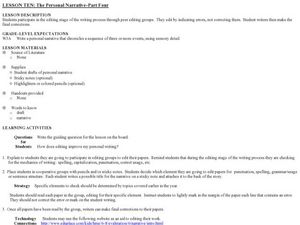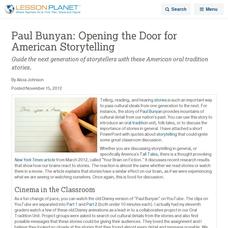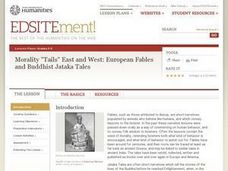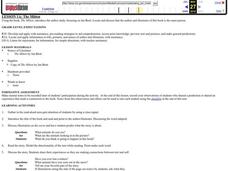Curated OER
Listening Comprehension: Retell Main Events of a Story
Story retell is a very important skill. Little learners use a story map and a previously heard story to walk through the retell and story sequencing process. They complete this activity as a whole class and then on their own.
Curated OER
The Personal Narrative
After writing a personal narrative, learners edit their work and that of their classmates. Using the imbedded link, pupils edit their paper. They form small groups and check each other's papers for spelling, grammar usage, sentence...
Curated OER
Paul Bunyan: Opening the Door for American Storytelling
Guide the next generation of storytellers with these American oral tradition stories.
Curated OER
Those Fabulous Fables
A video leads off this activity on fables, introducing the class to this important form of traditional storytelling. The group defines fable and hears an explanation of the origin of this type of folk tale. They summarize the story they...
Curated OER
Narrative Writing: Using Exact Words
Review the narrative writing process with your emerging story writers. They read a sample narrative and identify five vague verbs that could be replaced with a more exact, exciting verb. Then they write a personal narrative making sure...
Curated OER
Morality "Tails" East and West: European Fables and Buddhist Jataka Tales
Have your class explore Buddhist Jataka Tales to compare and contrast them to European fables. After defining fables, Jataka tales, and the elements of each, learners identify themes and patterns for both types of narratives and the...
Curated OER
Retelling Stella Louella's Runaway Book: Point of View
Stella Louella’s Runaway Book launches a study of point of view and storytelling. After reading the tale, class members retell the story from the point of view of another character. The scripted plan, developed by a teacher candidate,...
Curated OER
Chinese Takeout
Students use digital photography to illustrate a story. They research examples of narratives to determine how to choose photos that meet a specific purpose. Students research examples of narratives.
Curated OER
Which Story Matches the Given Theme?
Model for young learners how to determine the theme of a story. Read aloud Aesop’s The Fox and the Stork. Chart the plot and the main idea of the fable, showing class members how these elements support the theme. Fable titles for...
Curated OER
The Mitten
Explore children's literature by researching a book and it's author. Youngsters read the story The Mitten by Jan Brett and discuss the animals and characters mentioned in the story. Then, they practice retelling their favorite portion of...
Curated OER
Visualization: Cricket in Times Square
After reading The Cricket in Times Square chapter titled "Caught in the Kitchen," learners list three describing details about the characters and setting. Groups collaborate to find sensory details to support their character assertions....
Curated OER
Book Discussions in a Reading Partnership
Do you have a lot of different reading levels in your class? Pair kids up by level and have them choose a book to read independently. They will make predictions, ask questions, make connections, etc. Consider creating a general reading...
Curated OER
Developing a Topic for Writing Using an Idea Web
Teach your upper graders how to use an idea web to develop a topic for writing. After reading a variety of stories about friendship (a list of stories with the theme of friendship is included), model using an idea web. Class members...
Curated OER
Come Fly with Me . . . Open a Book: Travels through Literature
This detailed overview of a curriculum unit suggests using travel literature to engage and stimulate your third graders’ interest in reading. The suggested reading list includes fiction and non-fiction materials and offers urban children...
Curated OER
Story Elements that Support the Theme
Three great graphic organizers guide readers to see how the elements of plot and main idea can be charted to reveal the theme of a story. Model the process on the provided Direct Teaching Teacher Graphic Organizer using Aesop’s The...
Curated OER
Antagonist
Young learners explore the antagonist. They retell Hansel and Gretel and identify the witch and the stepmother as antagonists. They then brainstorm common character traits of an antagonist, and then write a paragraph describing...
Curated OER
How Many Ducks in the Pond?
Kindergarten counters will be delighted to doddle with the ducks pictured on a two-page illustrated worksheet. The six story problems and two equations ask learners to add and subtract as the ducklings dabble in the pond. An answer...
Curated OER
In the Park
In this writing worksheet, students look at a picture of a park and write a story about the picture. Students write their story on the lines provided on the worksheet.
Curated OER
The Lost Son Worksheet
In this religious education worksheet, students view six illustrations that depict the story of The Lost Son. Students write a sentence to go along with each picture.
Curated OER
Alphabet Poems
Develop fluency with a variety of works. Help kindergartners use multiple strategies to understand text and decoding. They will create an alphabet poem book on Kid Works 2 to illustrate and write their own poem. In the end, they will...
Curated OER
My First Book
Introduce young writers to the process of writing a book. Start by reading a book of your choice and discussing the essential elements of any book such as the cover, story, and illustrations as well as who is responsible for each...
Curated OER
Problem-Solving Strategy: Guess and Check
Teach your class how to guess and check to solve word problems. There are 4 single step word problems for them to solve.
Curated OER
Comparing and Contrasting Yourself to a Character
First and second graders explore character as a story element. They listen to the first part of the story First Day Jitters by Julie Danneberg and observe the teacher modeling a compare and contrast characters activity. Learners...
Curated OER
Order of Events
Read the book The Very Hungry Caterpillar and put the events of the story in order. Each event is written on a sentence strip and while the teacher reads, listeners can arrange the strips inthe correct order. After reading, reshuffle the...

























